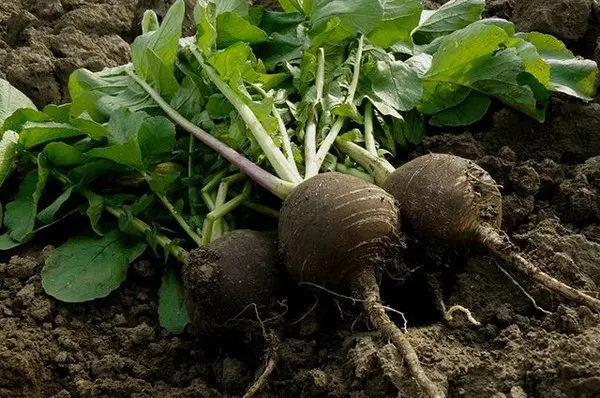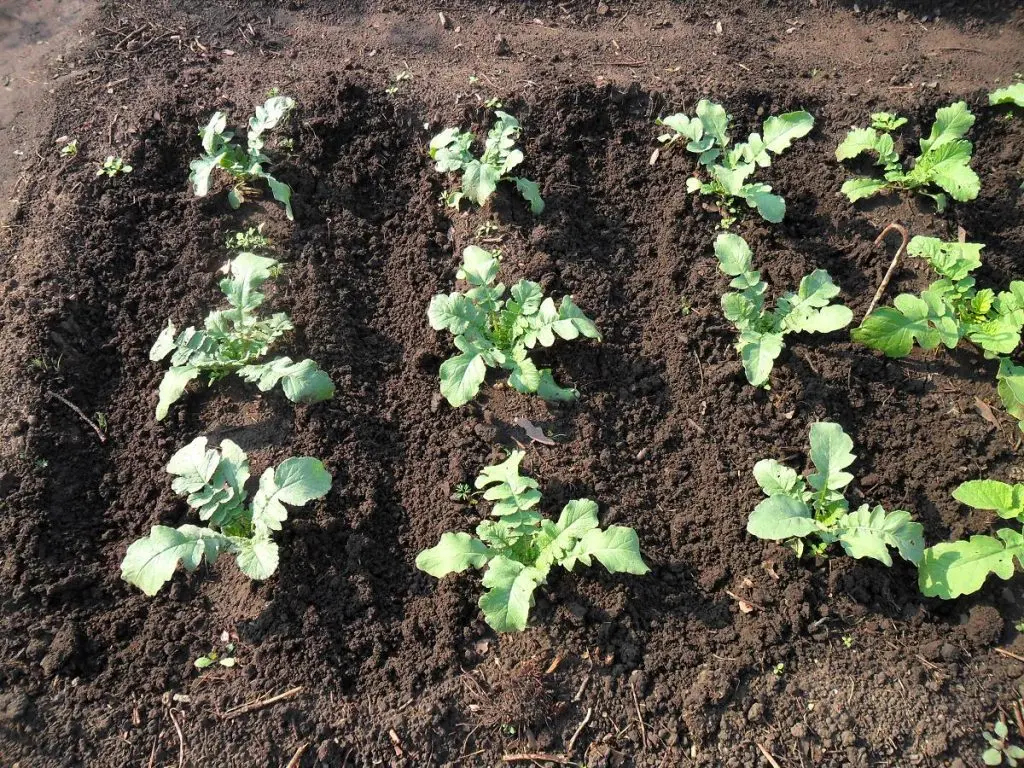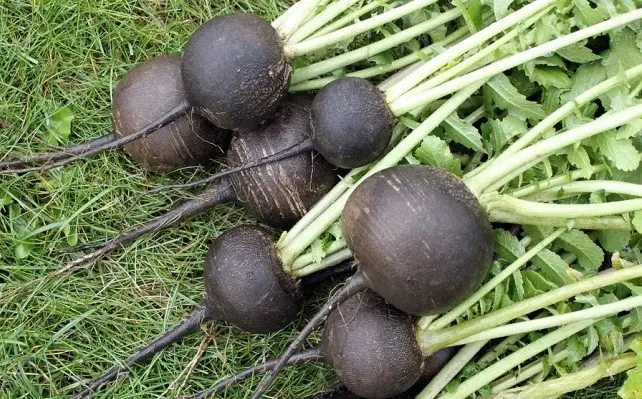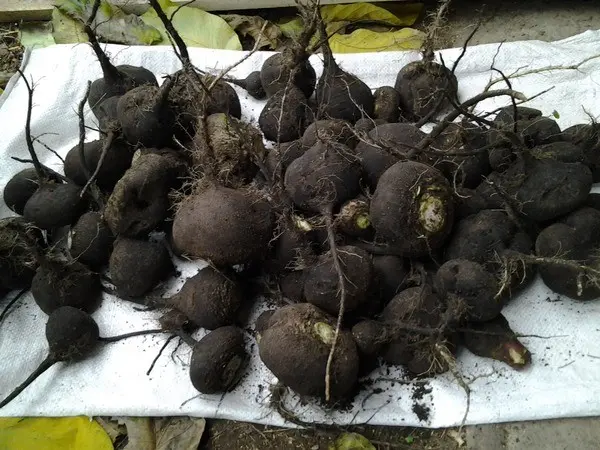Contents
Once upon a time, our gardeners were limited to growing only black or white radishes, but today the variety of species and varieties of this amazingly healthy vegetable, combined with new agrotechnical approaches, makes the question of when to remove radishes from the garden very relevant. After all, you can grow it for almost the entire season, starting with the spring sowing of early and early varieties, and ending with late, so-called winter varieties.
Summer harvest
In spring, radish is sown in open ground from late April to mid-May. When using greenhouses and hotbeds, this time limit is pushed back to the very beginning of spring. Usually early varieties are used, which promise the achievement of technical ripeness by root crops in 1 – 2 months.
Harvesting is carried out not at once, but as needed. They start with small, 2 – 3 cm in diameter root crops, which have already gained not only weight, but also taste and benefits. And they finish, as a rule, when the ripened root crops can no longer be kept in the ground, so as not to lose their qualities – they often become hollow, dry if they are not harvested for too long.
Specific dates depend on the variety (you need to carefully read the information on the seed packaging) and weather conditions, but most often this happens no later than the end of June or the very beginning of July. And summer residents begin to eat their radish from the end of May.
First, the owners try their radish – this is called selective harvesting – they pull out more small root crops, immediately eat them, some varieties and species directly with tops. So people get the vitamins and other useful substances they need, when there are still so few of them on the table, at the same time they control the ripening of vegetables. When the radish reaches the peak of its maturity according to its varietal characteristics, it becomes dangerous to keep it in the ground, because further there will only be a decline, that is, a decrease in its merits. The remaining crop is harvested completely.
Root crops need to be dug up, carefully cleaned from the ground, cut off a long root and tops, and then put in storage. In an apartment at room temperature, the crop can be stored for no more than a week, on the bottom shelf of the refrigerator – up to 20 days. If roots are kept in plastic bags, these bags should be opened or perforated to allow air to circulate and prevent condensation from accumulating. Dug up vegetables are usually eaten quickly – summer varieties do not require long-term storage.
Video “From seed to harvest radish”
This video shows the algorithm for growing radish.
Harvesting autumn and winter varieties
Radish is considered a vegetable of a short daylight hours, because with a day longer than 14-15 hours, it does not grow a root crop, but hurries to release a peduncle. That is why in the open field, without any tricks, it is planted so that active growth does not fall in the very middle of summer with its high temperatures (and many species also shoot from this) and long daylight hours. Winter radish is the conventional name for all varieties that are planted in the second half of summer. As a rule, these are late-ripening or mid-ripening varieties, they are planted starting from the second half of July. The exact timing can be determined based on the amount of time it takes for each particular variety to ripen, and the date when winter usually comes in a particular area. So it turns out that some people sow late radish in mid-July, others in August, and still others in general in its last days.
Radish harvesting should be completed before frost. Although it is considered a frost-resistant vegetable, this only means that the plant can easily endure short-term frosts without harm to itself. But if the root crop freezes, it will lose most of its useful properties and will not be able to be stored for a long time, and this is precisely what late varieties are grown for – in order to have this storehouse of vitamins and elements at hand all winter, when all other vegetables are no longer so useful.
In autumn, the radish is also dug up (or pulled out) selectively so that there is a fresh vegetable on the table, and also to monitor the degree of ripening. Then they choose a cool, fine day to harvest the entire crop. This usually happens in October, so in the Middle lane and in the Urals, the radish is harvested after the Feast of the Intercession (October 14), in the southern regions later, and in the northern regions earlier.
The radish is carefully removed from the ground with the help of hands, if the soil is loose, or with the help of shovels and forks, if it is more dense, heavy. A couple of days before this, you can crush the tops, but you can also do without it. The extracted radish is left in the garden (in dry weather) for several hours to dry. After that, carefully shake off the remnants of the earth, cut off the leaves, leaving petioles up to 2 cm, sort out the entire crop. The most even, without mechanical damage and other flaws, the roots are selected for long-term storage, the rest are put in the refrigerator (cutting off the roots and tops) for use in the next 3 weeks.
when to remove the radish from the garden for storage (missing dilution 1 time(s))
when to dig a radish (missing dilution 1 time(s))
Storage in winter
Let’s figure out when to store the radish from the garden and when to start digging up this vegetable. In order for the radish to be stored for 3 – 6 months, it needs to create certain conditions: the air temperature should be within 0 – +3 degrees, and humidity – from 85 to 95 percent. Some types of radish can lie at sub-zero temperatures – then the lower limit is pushed back to -3 degrees. Such conditions are easiest to create in the cellar or basement. So they usually store a vegetable along with other vegetables – potatoes, beets, carrots. It can be poured into small slides, up to 1 m high, or it can be folded into wooden or plastic boxes with holes, put them on top of each other. Root crops will have to be periodically sorted out and removed those that begin to deteriorate in order to preserve the rest.
The best way may be to keep in wet sand – the root crops are laid out in boxes so that they do not touch each other, the layers are poured with clean river sand. This sand will need to be moistened – then the radish will not lose its juiciness and elasticity.
In the absence of a cellar, the vegetable can be folded into a bag of dense polyethylene, put in an unheated room, make sure that the temperature there does not fall below -3 degrees.
Heaps or trenches are also suitable for long-term storage of crops. You can pour a vegetable on the bottom of such a trench, cover it with wet sand or earth from above, and put a layer of dry straw on it. From above, everything is covered with earth, a tubercle is made so that precipitation rolls off it, and moisture does not get into the trench. You can put boxes with root crops at the bottom of the trench, and cover them with earth and straw. Straw should not be placed directly on vegetables so that they do not dry out, damp earth or sand will retain moisture in them, and straw will create an air cushion to maintain temperature. This method is bad because it is difficult to sort out root crops and remove spoiled ones.
The varieties “Winter round black” and “Winter round white” are best stored. But all the described methods are suitable for other varieties and species. Experts say that the roots of our vegetable, unlike other vegetables, are healthy, and their medicinal properties only increase during long-term storage.
Video “How and where to store radish”
In this video, experienced gardeners will tell you how to properly store radishes.









